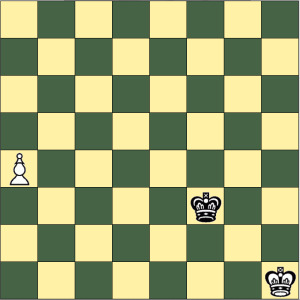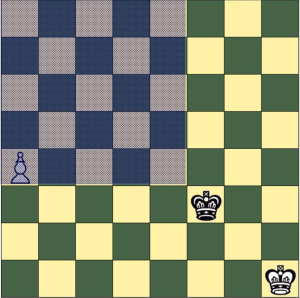How to tell if the King can catch a Pawn in a race
(Video below the jump.)
Often a game of chess will end with two Kings and one Pawn: King and Pawn vs. King. And very often in those situations, the question is simply this: can the King catch the Pawn?
In the following diagram we have just such a situation … the King would like to catch the Pawn before it reaches the 8th rank to become a Queen, and the Pawn is trying to race to its 8th rank. Who wins? There is a simple rule to decide which side wins these races.

The rule is called the “square of the Pawn.”
The way to quickly decide the race of the Pawn vs. the King is to visualize in your mind a square where the Pawn is at one corner, and the diagonally opposite corner is on the Pawn’s 8th rank (the rank where the Pawn would promote to a Queen).
The square of the Pawn in the diagram we are considering would look like this:

(The square of the Pawn is the blue shaded area in the diagram.) The rule works like this: if the King can move into the square of the Pawn, then the King can catch the Pawn.
So in the diagram, with Black to move, he has only one move that allows him to catch the Pawn: Ke4. (If you don’t understand chess notation, read my article entitled “Chess Notation Part 1” to learn about reading and recording chess moves.)
You can use the square of the Pawn in many situations like this, and it will help you to visualize and evaluate many endgame positions much more easily.
If you want to watch a video with a discussion of the square of the Pawn, check out the video below. Also, see this important caveat about calculating the square of the Pawn when the Pawn stands on its home square!

thanks man for this nice video …
The endgame with 1 pawn vs. 1 pawn is essential as well, and not so easy.
Yes, you are right. I’ll be adding articles about K&P v. K&P shortly.